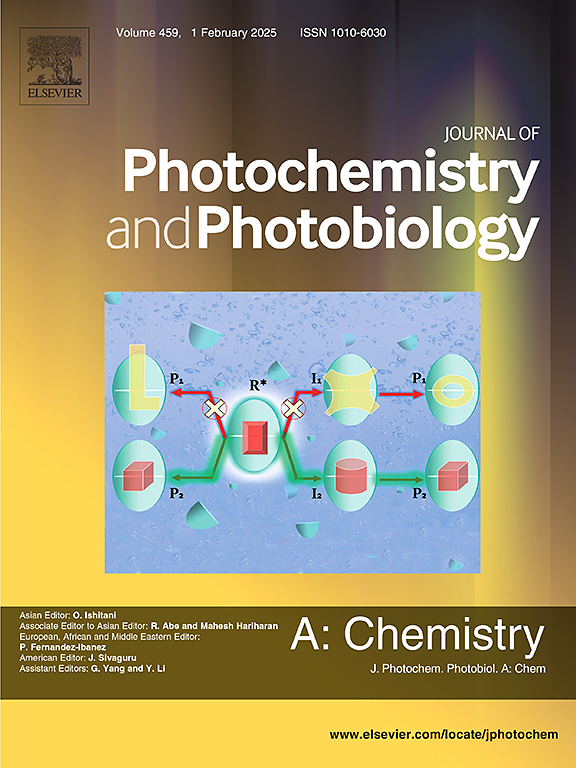Porphyrins functionalized covalent organic frameworks for enhanced photodynamic and photothermal antibacterial
IF 4.1
3区 化学
Q2 CHEMISTRY, PHYSICAL
Journal of Photochemistry and Photobiology A-chemistry
Pub Date : 2025-03-10
DOI:10.1016/j.jphotochem.2025.116386
引用次数: 0
Abstract
Porphyrins, as important organic photosensitizers, have attracted widespread attention in photodynamic and photothermal therapy. However, the poor water solubility of porphyrins causes their tendency to aggregate in living organisms, resulting in unsatisfactory photodynamic and photothermal effects. In this work, we have ingeniously designed a kind of photoactive COFs-Tph by covalent coupling hydrophobic porphyrin (Tph) on the surface of porous covalent organic frameworks (COFs) with free aldehyde groups. Under 660 nm light irradiation, the proposed COFs-Tph exhibit high 1O2 generation ability and photothermal conversion efficiency (50.56 %) simultaneously. Importantly, the COFs-Tph display the obviously enhanced photodynamic and photothermal performance compared to Tph, which is attributed not only to the high loading capacity of COFs on Tph, but also to covalent coupling between COFs and Tph that improves the dispersibility of Tph. Because of the excellent phototherapeutic ability, the COFs-Tph are used as the antibacterial nanoreagents to kill 100 % both Gram-negative and Gram-positive bacteria in just 5 min. This work develops a powerful strategy to construct phototherapeutic nanoreagents with enhanced photodynamic and photothermal properties and achieve efficient antibacterial purposes.

求助全文
约1分钟内获得全文
求助全文
来源期刊
CiteScore
7.90
自引率
7.00%
发文量
580
审稿时长
48 days
期刊介绍:
JPPA publishes the results of fundamental studies on all aspects of chemical phenomena induced by interactions between light and molecules/matter of all kinds.
All systems capable of being described at the molecular or integrated multimolecular level are appropriate for the journal. This includes all molecular chemical species as well as biomolecular, supramolecular, polymer and other macromolecular systems, as well as solid state photochemistry. In addition, the journal publishes studies of semiconductor and other photoactive organic and inorganic materials, photocatalysis (organic, inorganic, supramolecular and superconductor).
The scope includes condensed and gas phase photochemistry, as well as synchrotron radiation chemistry. A broad range of processes and techniques in photochemistry are covered such as light induced energy, electron and proton transfer; nonlinear photochemical behavior; mechanistic investigation of photochemical reactions and identification of the products of photochemical reactions; quantum yield determinations and measurements of rate constants for primary and secondary photochemical processes; steady-state and time-resolved emission, ultrafast spectroscopic methods, single molecule spectroscopy, time resolved X-ray diffraction, luminescence microscopy, and scattering spectroscopy applied to photochemistry. Papers in emerging and applied areas such as luminescent sensors, electroluminescence, solar energy conversion, atmospheric photochemistry, environmental remediation, and related photocatalytic chemistry are also welcome.

 求助内容:
求助内容: 应助结果提醒方式:
应助结果提醒方式:


